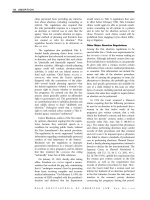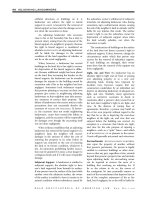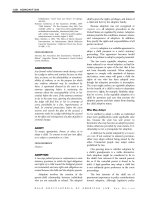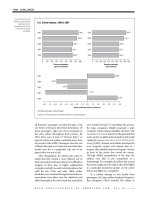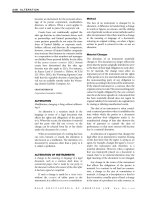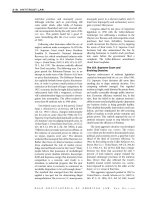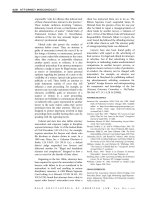Gale Encyclopedia Of American Law 3Rd Edition Volume 2 P27 pot
Bạn đang xem bản rút gọn của tài liệu. Xem và tải ngay bản đầy đủ của tài liệu tại đây (310.94 KB, 10 trang )
no clear consensus against executing mentally
retarded defendants who had been convicted of
murder.
However, just 13 years later the Court
found that “standards of decency” had evolved
to a point at which mentally retarded defen-
dants could no longer be made subject to capital
punishment without violating the cruel and
unusual punishment clause of the Eighth
Amendment (
ATKINS V. VIRGINIA, 536 U.S. 304,
122 S. Ct. 2242, 153 L. Ed. 2d 335 [U.S. 2002]).
The Court emphasized the fact that since Penry
18 states had passed legislation excluding the
mentally retarded from the class of defendants
who are eligible for capital punishment. Apply-
ing the same type of analysis in Stanford v.
Kentucky, 492 U.S. 361, 109 S. Ct. 2969, 106 L.
Ed. 2d 306 (1989), the Court found that there
was no national consensus prohibiting the
EXECUTION of juvenile offenders over age 15.
However, in Roper v. Simmons, 543 U.S. 551,
125 S. Ct. 1183, 161 L. Ed. 2d 1 (2005), the
Court ruled that juveniles who are under the age
of 18 when they commit capital crimes may not
be sentenced to death.
The Court likewise found sufficient proof of
consensus against making rape defendants as a
class that was eligible for capital punishment,
stressing that only one jurisdiction in the
country at the time of its dec ision allowed
capital punishment for the rape of an adult
woman (Coker v. Georgia, 433 U.S. 584, 97 S.
Ct. 2861, 53 L. Ed. 2d 982 [2002]).
Death b y electrocution has been challenged
several times as being inconsistent with
“evolving standards of d ecency”.Inaseries
of Florida cases, the U.S. Supreme Court
denied
CERTIORARI in appeals where the PETI-
TIONER
offered proof that during the execution
the electric chair was engulfed by flames and
that smoke had emanated from the inmate’s
head. B ut the F lorida Supreme Court ruled
that death by electrocution does not violate the
Eighth Amendment’s prohibition of cruel and
unusual, citing evidence that execution by
electrocution renders an inmate instan-
taneously unconscious, thereby making it
impossible to feel pain when the electrical
current is properly maintained (Provenzano v.
Moore, 744 So. 2d 413 (Fla. 1999); cert denied,
528 U.S. 1182, 120 S. Ct. 1222, 145 L. Ed. 2d
1122 [2000]).
Capital Punishment for DWI-Related
Offenses
Many observers expected the “evolving stan-
dards of decency” test to be invoked by a North
Carolina
DEFENDANT when prosecutors sought to
impose the death penalty for crimes he
committed during a 1996 drunk-driving inci-
dent that left two college students dead. Thomas
Richard Jones was charged and convicted on
one count of driving while impaired, one count
of
ASSAULT with a deadly weapon, three counts of
assault with a deadly weapon inflicting serious
injury, and two counts of first-degree murder
under the
FELONY-MURDER RULE. During the
penalty phase, the jury rejected the prosecu-
tion’s arguments for capital punishment, in-
stead sentencing Jones to life in prison.
When Jones appealed his
CONVICTION,the
North Carolina Supreme Court did not review
his sentence under an Eighth Amendment
analysis. Rather, the state’s high court ruled that
any sentence that Jones might have received for
first-degree murder would not have been
justified, because a first-degree murder charge
can only be supported by proof that the
defendant possessed a “specific intent” to
commit the crime. At a minimum, the court
said, proof of
SPECIFIC INTENT requires evidence
that the defendant had “an actual intent to
undertake the conduct resulting in death; thus,
even if the killing itself was not intended, the
actual intent to torture, poison, starve, or
SOURCE: U.S. Department of Justice, Bureau of Justice Statistics, Capital
Punishment, 2007.
PRISONERS EXECUTED UNDER CIVIL AUTHORITY IN THE UNITED STATES, 1977 TO 2007
Total prisoners executed: 1,099
Executions by method: 1,099
Other races 14
Hispanic
81
Lethal gas 11
Hanging 3
Firing squad 2
Black
373
White
631
Electrocution
154
Lethal injection
929
Capital Punishment
ILLUSTRATION BY GGS
CREATIVE RESOURCES.
REPRODUCED BY
PERMISSION OF GALE,
A PART OF CENGAGE
LEARNING.
GALE ENCYCLOPEDIA OF AMERICAN LAW, 3
RD E DITION
248 CAPITAL PUNISHMENT
imprison the victim must be present … for the
killing to qualify as first-degree murder.” The
North Carolina Supreme Court rejected the
state’s argument that specific intent could be
“implied” from the defendant’s reckless conduct
(State v. Jones, 538 S.E. 2d 917 [N.C. 2000]). No
state court since State v. Jones has successfully
prosecuted a defendant for first-degree murder
arising out of a drunk-driving-related offense.
Racial Bias
In 1983 Professor David C. Baldus, of the
University of Iowa College of Law, published
a study on the capital punishment system in
the state of Georgia. The figures he assembled
showed that between 1973 and 1979, killers
whose victims were white were 11 times more
likely to be sentenced to death than were killers
whose victims were black.
Baldus’s study was used by death row inmate
Warren McClesky in an appeal that came before
the U.S. Supreme Court (McClesky v. Kemp, 481
U.S. 279, 107 S. Ct. 1756, 95 L. Ed. 2d 262).
Although the Court accepted the validity of the
study, it found the statistics “insufficient to
demonstrate unconstitutional discriminatio n ”
or “to show irrationality, arbitrariness, and
capriciousness.”
Other studies have yielded equally disturb-
ing numb ers regarding the statistical differences
between the system’s treatment of blacks and
whites. For example, between 1976 and 1995,
a total of 245 co nvicts were executed; 84 percent
of their victims were white, although fewer than
50 percent of all murder victims are white.
Many critics argue that statistics demonstrating
racial bias in the administration of capital
punishment prove that the death penalty, even
if constitutional in concept, is unconstitutional
as applied in the United States—violating at
least the
EQUAL PROTECTION clause of the
FOURTEENTH AMENDMENT.
Justice Lewis F. Powell Jr., who voted with
the majority in McClesky to deny a racial-bias
challenge to the capital punishment system,
later informed a biographer that he since had
come to regret his vote.
Consideration of Mitigating Factors
In general, the jury m ay not be precluded from
considering, and may not refuse to consider,
any relevant mitigating evidence in determin-
ing whether capital punishment is the
appropriate sentence for a particular defen-
dant. However, the Eighth Amendment does
not require courts to instruct a jury during the
penalty phase that it has both an obligation and
the authority to consider the mitigating factors
deemed relevant by state law (Bu chanan v.
Angelone, 522 U.S. 269, 118 S. Ct. 757, 139 L.
Ed. 2d 702 [1998]). Instead, it is suff icient for a
court to i nstruct the jury that it must impose a
life sentence if, after conside ring “all the
evidence,” the jury does not believe that capital
punishment is justified.
Once convicted and sentenced to death, death
row inmates may again cite mitigating factors in
making an appeal for leniency or
CLEMENCY from
the state’s
PAROLE board or another EXECUTIVE
BRANCH
department. Such appeals often cite
mitigating factors that existed either before, after,
or at the time the crime was committed. However,
parole boards and related executive branch
departments are under no obligation to give
mitigating evidence any weight and may typically
reject a death row inmate’s request for clemency
without providing any reason for doing so.
For example, the Texas Parole Board was
flooded with requests to grant clemency to
Karla Faye Tucker, a death row inmate who had
been convicted of brutally killing two people
with a pickax during a 1983 robbery. Despite
evidence that Tucker was 23 years old and high
on drugs at the time of the crime, that she had
been addicted to drugs since she was eight years
old, and that she had been a prostitute since age
14, the sentencing jury found more compelling
other evidence showing that Tucker had a
history of violent behavior, that she had
received sexual gratification every time she
struck one of the victims with the pickax, that
she had talked of killing two others to prevent
them from telling police about the murders, and
that she had planned future crime sprees to raid
drug labs, kill the people who worked there, and
steal their property.
During her 14 years on death row, how-
ever, Faye underwent a religious conversion to
Christianity that many people believed was
sincere. In fact, religious leaders from around
the world, including Pope John Paul II, made
personal appeals to have Tucker’s sentence
commuted to life in prison. The European
Parliament and the
UNITED NATIONS also publicly
sought clemency for Tucker. The Karla Faye
Tucker who was on death row, they all said,
was not the same person who had committed
GALE ENCYCLOPEDIA OF AMERICAN LAW, 3RD E DITION
CAPITAL PUNISHMENT 249
the gruesome murders more than a decade
earlier.
The Texas
BOARD OF PARDONS and Paroles
refused to stay the execution, finding that
neither Tucker’s gender nor her religious
conversion were sufficient grounds to com-
mute her sentence. “Mercy was already consid-
ered by the jurors when they sentenced her to
die,” the chairman of the pardons and parole
board said. Then-Texas governor
GEORGE W.
BUSH also rejected T ucker’s requests for cl em-
ency. Tucker challenged the adequacy of the
Texas executi ve-clemency procedures, but the
Texas Court of
CRIMINAL Appeals concluded that
“[a]n inmate has no constitutional or inherent
right to
COMMUTATION of her sentence” (Ex part e
Tucker, 973 S.W. 2d 950 [Tex. Crim. App.
1998]). Clemency, the court wrote, is a matter
that rests solely within the “unfettered discre-
tion ” of the executive branch of the state
government. On February 3, 1998, Tucker
becamethefirstwomantobeexecutedin
Texas since the
CIVIL WAR.
Deterrent Effect
Since the beginning of the twentieth century,
many studies have been conducted on the
deterrent effect of capital punishment. More
often than not, the results have proven
inconclusive; no hard evidence exists to verify
the theory that the threat of such a harsh
punishment will sway criminals from their
actions. In fact, some statistics indicate that
the opposite is true; in some instances, states
that employ capital punishment have a higher
incidence of
HOMICIDE than neighboring states
that do not employ the death penalty.
The Costs of Capital Punishment
I
n 1989 the state of Florida executed
42-year-old Ted Bundy. Bundy con-
fessed to 28 murders in four states.
During his nine years on death row, he
received three stays of
EXECUTION. Before
he was put to death in the electric
chair, Bundy cost taxpayers more than
$5 million.
In a country where some 65 percent of
the population favors the death penalty,
many people may feel that Bundy got what
he deserved. A further question, however,
is whether U.S. taxpayers got their
money’s worth. When a single sentence
of death can cost millions of dollars to
carry out, does it make economic sense to
retain the death penalty?
The actual execution of an inmate is
typically quick, simple, and inexpensive;
the capital punishment system is far
more complex and costly. To resolve
issues of unconstitutionality that the
Supreme Court found in Furman v.
Georgia (408 U.S. 238, 92 S. Ct. 2726,
33 L. Ed. 2d 346 [1972] ), states found it
necessary to introduce a complex appeals
process that would guarantee the rights
of death row inmates. Capital trials are
much more expensive to carry out than
are their noncapital counterparts because
of the price at stake, the life of the
accused. Evidence gathering is also more
expensive: Evidence must be collected
not only to determine the guilt or
innocence of the accused but also to
support or contradict a sentence of
death. All sentences of death face a
mandatory review by the state supreme
court, which increases legal fees. More-
over, in Florida, the state supreme court
spends half of its time reviewing death
penalty cases. If a case advances farther in
the state or federal appeals process, the
costs continue to rise.
Appeals of a death sentence guaran-
tee great expense to the taxpayer, as the
state pays both to defend and to
PROSE-
CUTE
death row inmates. Public defenders
in such appeals openly admit that their
goal is delay, and prosecutors and state
attorneys slow the process by fighting
access to public records and allowing
death row defendants to sweat out their
cases until the last minute.
Abolitionists believe that the existing
system cannot be repaired and must be
abandoned. The alternative sentence, life
IMPRISONMENT without PAROLE, achieves
the same result as capital punishment,
they argue. Like the death penalty, a life
sentence permanently removes the con-
vict from the community against which
he or she committed
CRIMES, and it is far
less expensive. A 2008 report by the
California Commission on the Fair
Administration of Justice estimated that
the annual cost of the state death penalty
system was $137 million dollars. Half of
that amount goes to housing 670 inmates
on death row; it costs $90,000 per year
more to keep an inmate on death row
compared to incarcerating an inmate in a
maximum security system who has been
sentenced to life imprisonment without
the possibility of parole.
According to a study by the Indiana
CRIMINAL LAW Study Commission released
in 2002, executions cost the state
GALE ENCYCLOPEDIA OF AMERICAN LAW, 3RD E DITION
250 CAPITAL PUNISHMENT
The U.S. Supreme Court justices in the
Furman case, both concurring and dissenting,
often referred to studies that showed no conclusive
correspondence between c apital punishment and
the frequency with which capital crimes were
committed. A later accounting revealed that
during the m oratorium o n capital punishment,
from 1967 to 1976, t he nation al homic ide ra te
nearly doubled. Since then, depending on the
study c onducted, e vidence has been presented t o
show that capital punishment h as no dete rrent
effect; that the implementation of the death penalty
is directly related to a decrease in capital crime; and
that the implementation of the death penalty is
directly related to an increase in capital crime.
Although some opponents of the death
penalty are quick to argue that capital punish-
ment has no deterrent effect, many supporters
feel that the purpose of capital punishment is
retribution, not deterrence. Many individuals,
especially those with close ties to the victims, are
more often concerned that the particular
convicted criminal pay for the crime than that
other persons be deterred through punishment
of the
PERPETRATOR.
Morality and Emotion
Emotions might have played a part in the
Furman decision. Burger, in his dissent, warned
that the Court’s “constitutional inquiry … must
be divorced from personal feelings as to the
morality and efficacy of the death penalty.”
Justice
HARRY A. BLACKMUN, who joined Burger in
his dissent, later renounced his belief in the
death penalty for reasons that another justice
saw as partly personal.
38 percent more than the costs of
keeping an inmate incarcerated for life.
Similarly, a 1993 study at Duke Univer-
sity showed that between 1976 and 1992,
the state of North Carolina spent in
excess of $1 billion on executions
or $2.16 million per execution. A 2008
report by the Kansas Department of
Corrections found that capital cases are
70 percent more expensive than compa-
rable non-capital cases. The median
death penalty cost $1.26 million.
Not only are the costs of execution
excessive but so too are the t ime delays. It
is not unusual for an individual to wait on
death row for more than ten years. In the
1995 case Lackey v. Texas (514 U.S. 1045,
115 S. Ct. 1421, 131 L. Ed. 2d 304),
Clarence Allen Lackey, who had been on
death row for 17 years, claimed that such
a duration constituted
CRUEL AND UNUSUAL
PUNISHMENT
. Although his MOTION was
denied, Justices
JOHN PAUL STEVENS and
STEPHEN BREYER admitted that the concern
was not without warrant.
Opponents of capital punishment
point out that abandoning the death
penalty would make available many
millions of dollars as well as thousands
of hours that the courts could allocate to
other aspects of the criminal justice
system. The amount of money necessary
to execute a single inmate might be used
to put several criminals behind bars for
the remainder of their lives.
Supporters of capital punishment
agree with detractors on one issue:
The death row appeals process is far
too complex and expensive. However,
whereas opponents of the death penalty
use this as a reason to reform
SENTENCING,
supporters use it as a reason to reform the
system of appeals. Supporters argue that
thorough reform of the appeals process
would free up as much money as abolish-
ing the death penalty; expenses could be
cut while capital punishment is retained.
Immediately following the execution
of Bundy, Chief Justice
WILLIAM H.
REHNQUIST called for changes in the
procedure for appealing death sentences.
Noting that the Supreme Court had
turned down three emergency appeals
by Bundy in the hours just prior to his
execution, the chief justice said, “Surely it
would be a bold person to say that this
system could not be improved.”
In a 1995 interview, President
BILL
CLINTON
, a staunch supporter of capital
punishment, called the appeals process
ridiculous and in need of reform.
Clinton, like other supporters of the
death penalty, saw appeals reform as
paramount if capital punishment is to be
efficiently and effectively carried out.
Congress responded by enacting the
Antiterrorism and Effective Death Penalty
Act of 1996 (Pub. L. 104-132). The act
sought to limit the number of post-
conviction petitions for
HABEAS CORPUS
filed by death row inmates. Since its
enactment the Supreme Court has issued
numerous rulings on the act’s provisions;
most of its rulings have sustained strict
time limits and procedural rules that
limit appeals, but the number of execu-
tions per year remains low. As of 2008,
over 3,200 inmates were on death row,
yet the annual rate of executions fluc-
tuates between 40 and 70. It is likely that
a number of death row inmates will die
from natural causes.
Supporters also argue that too many
rights are provided to death row inmates.
The appeals process is too kind to
convicts, they argue, and ignores the
pain that persists in the aftermath of the
criminals’ actions. Family members of
victims of capital crimes are expected to
wait years, while perpetrators abuse the
system to forestall execution of the
sentence imposed.
FURTHER READING
Streib, Victor L. 2003. Death Penalty in a
Nutshell. St. Paul, Minn.: Thomson/West.
CROSS REFERENCES
Cruel and Unusual Punishment; Due Process
GALE ENCYCLOPEDIA OF AMERICAN LAW, 3RD E DITION
CAPITAL PUNISHMENT 251
In 1994, in Callins v. Collins, 510 U.S. 1141,
114 S. Ct. 1127, 127 L. Ed. 2d 435, Blackmun
wrote a dissenting opinion in which he con-
demned the practice of capital punishment
in the United States. He argued that “no
combination of procedural rules or substantive
regulations ever [could] save the death penalty
from its inherent constitutional deficiencies”—
“arbitrariness, discrimination, caprice, and mis-
take.” Justice
ANTONIN SCALIA criticized Black-
mun’s position, writing that Blackmun had based
his dissent on intellectual, moral, and personal
reasons, rather than on the authority of the
Constitution.
Adequacy of Resources for
Capital Defenses
In 2007 the AMERICAN BAR ASSOCIATION issued a
report indicating that most states operate with
capital defense systems that are underfunded
and staffed with unqualified lawyers who lack
resources to provide adequate defenses for
death row inmates. Based on this report, the
ABA requested a national moratorium on the
death penalty.
Death Penalty Statistics and Trends
Despite the controversy, the constitutionality of
capital punishment has been upheld and
continues to be an acceptable practice in 36
states. As of January 1, 2009, a total of 3,297
inmates were on death row throughout the
United States. In 2008 a total of 37 persons in
nine states were executed, including 18 inmates
in Texas. Between 1977 and 2007, the highest
number of inmates executed in one year was 98
in 1999.
FURTHER READINGS
Banner, Stuart. 2002. The Death Penalty: An American
History. Cambridge, MA: Harvard Univ. Press.
Bedau, Hugo Adam, and Paul G. Cassell, eds. 2004. Debating
the Death Penalty: Should America Have Capital
Punishment? New York: Oxford Univ. Press.
Bigel, Alan I. 1994. “Symposium on Capital Punishment—
Justices William J. Brennan, Jr., and Thurgood Marshall
on Capital Punishment: Its Constitutionality, Morality,
Deterrent Effect, and Interpretation by the Court.”
Notre Dame Journal of Law, Ethics, and Public Policy
(Thomas J. White Center on Law and Government).
Foley, Michael A. 2003. Arbitrary and Capricious: The
Supreme Court, the Constitution, and the Death Penalty.
Westport, CT: Praeger.
Rodriguez, Roxanne. 2001. The Modern Death Penalty:
A Legal Research Guide. Buffalo, NY: W.S. Hein.
Von Drehle, David. 1995. Among the Lowest of the Dead: The
Culture of Death Row. New York: Times Books.
CROSS REFERENCES
Criminal Law; Criminal Procedure; Criminology;
Witherspoon v. Illinois.
CAPITAL STOCK
All shares constituting ownership of a busines s,
including common stock and preferred stock. The
amount of shares that a corporate charter requires
to be subscribed and paid, or secured to be paid,
by shareholders. The amount of stock that a
corporation may issue; the amount actually
contributed, subscribed, or secured to be paid on.
The liability of the corporation to its shareholders
after creditors’ claims have been settled. The
valuation of the corporation as a business
enterprise.
Capital stock is distinguishable from the
property and assets of the corporation. The
property of a corporation fluctuates and may be
greater or less than the original capital invested,
but the capital stock remains intact and
unaffected by the vicissitudes of business.
Undivided profits, or surplus, are not part of
the capital stock, although they are included in
the general capital or assets of the corporation.
The capital stock of a corporation serves
only corporate purposes. It functions as security
for the creditors of the corporation who have
relied on its existence, because it cannot be
diverted or withdrawn to the detriment of
corporate creditors. Capital stock is sometimes
regarded as a trust fund.
CAPITALIZE
To regard the cost of an improvement or other
purchase as a capital asset for purposes of
determining income tax liability. To calculate
the net worth upon which an investment is based.
To issue company stocks or bonds to finance an
investment.
The owner of a business may capitalize the
expense of renovating a factory to maximize his
or her after-tax profits, since such expens es may
be used to decrease the pretax profits, thereby
reducing the amount of profits subject to
TAXATION.
An individual may compute the net worth
of shares of stock, in order to treat them as
capital assets for
INCOME TAX purposes. Such
treatment often results in more favorable rates
of taxation on the profits made when assets are
sold because they are considered capital gain s.
GALE ENCYCLOPEDIA OF AMERICAN LAW, 3RD E DITION
252 CAPITAL STOCK
CAPITATION TAX
An assessment levied by the government upon a
person at a fixed rate regardless of income or
worth.
Since it is a tax upon the individual, and not
upon merchandise, a capitation tax is frequently
labeled a head tax. A
POLL TAX is a capitation tax.
CAPTION
The standardized heading of a legal instrument,
such as a motion or a complaint, which sets forth
the names of the parties in controversy, the name
of the court, the docket number, and the name of
the action.
v
CARDOZO, BENJAMIN NATHAN
Benjamin Nathan Cardozo was a New York
state court judge, an ASSOCIATE JUSTICE on the
U.S. Supreme Court, and an influential legal
scholar.
Cardozo was born May 24, 1870, in New
York City, the youngest son in a family of six
children. His parents were descendants of
Portuguese and Spanish Jews who had settled
in New York before the Revolutionary War. His
father, Albert Cardozo, was a trial court judge
who was forced to resign his seat because of
allegations, which were never proved, of
improper conduct involving the then corrupt
New York City government. Cardozo was
tutored during his early life by well known
clergyman and teacher Horatio Alger and
entered Columbia College at the age of fifteen.
He earned a bachelor’s degree in 1889 and a
master’s degre e in 1890, then enrolled at
Columbia Law School. He was granted admis-
sion to the New York state bar in 1891 without
having received his law degree.
After completing his legal training and
passing the
BAR EXAMINATION, Cardozo began
practicing appellate law with his brother. He
soon became a prominent practitioner in his
own right in the fields of corporate and
COMMERCIAL LAW. He often acted as consultant
to other law firms, writing appeal briefs for
other lawyers and appearing frequently before
the New York Court of Appeals, the state’s
highest court. His extensive appellate experience
led him to write his first book, Jurisdiction of the
Court of Appeals of the State of New York,
published in 1903. In addition, judges often
appointed him to act as referee in complicated
matters of commercial law, one of his areas of
specialty.
In 1913, after 23 years in private practice,
Cardozo was nominated and elected as a judge
on the New York Supreme Court, the state’s
trial-level bench. Only six weeks later, he was
designated to serve temporarily as an associate
judge on the Court of Appeals. He remained a
temporary judge of the Court of Appeals unt il
1917, when he was appointed to fill a vacant and
permanent seat, and in 1926 he was elected
chief judge.
During his tenure on the Court of Appeals,
Cardozo made his mark as an influential and
celebrated jurist and moved the New York court
to the forefront of the nation’s state courts.
With respect to
TORT LAW, the court under
Cardozo greatly expanded the protection of-
fered to individuals injured by the
NEGLIGENCE of
others. In
MACPHERSON V. BUICK MOTOR CO., 217
N.Y. 382, 111 N.E. 1050 (1916), per haps
Cardozo’s most influential tort opinion, the
court held Buick liable for the negligent
construction of a defective wheel that injured
a purchaser who had bought the car not from
Buick but from an automobile dealer. Cardozo’s
decision to look beyond the contractual rela-
tionship between the buyer and seller to the
manufacturer for redress helped lay the ground-
work for the development of
PRODUCT LIABILITY,
now a common feature of the law, which allows
for recovery for injuries even if the consumer
had no contractual relationship with the
manufacturer. But Cardozo was also willing to
impose some commonsense limits on tort
liability. In the classic decision Palsgraf v. Long
Island Railroad, 248 N.Y. 339, 162 N.E. 99
(1928), he authored the majority opinion
establishing that a person can be held negligent
only for a harm or injury that is foreseeable and
not for every injury that follows from the
negligence. As Cardozo put it, “[T]he orbit of
the danger as disclosed to the eye of reasonable
vigilance would be the orbit of duty.”
Cardozo’s influence was also strongly felt in
the law of contracts. He wrote the majority
opinion in Wood v. Duff-Gordon, 222 N.Y. 88,
118 N.E. 214 (1917), perhaps his best known
and most widely quoted decision concerning
the implied elements of a contract. In Wood and
his other contract law decisions, Cardozo made
clear his views that, whenever possible, courts
should attempt to instill fairness in an ambigu-
ous contract by analyzing and interpreting its
THE GREAT TIDES
AND CURRENTS
WHICH ENGULF THE
REST OF MEN DO NOT
TURN ASIDE IN THEIR
COURSE AND PASS
THE JUDGES BY
.
—BENJAMIN CARDOZO
GALE ENCYCLOPEDIA OF AMERICAN LAW, 3RD E DITION
CARDOZO, BENJAMIN NATHAN 253
implicit terms to cover situations that the
parties may not have provided for explicitly.
In 1932, when ninety-year-old Oliver Wen-
dell Holmes Jr., announced his retirement from
the U.S. Supreme Court, politicians, lawyers,
and legal scholars publicly campaigned for
Cardozo to succeed him. President
HERBERT
HOOVER
, though impressed with Cardozo’s
credentials and intellect, was initially lukewarm
about nominating him to the Court. Two other
New Yorkers, Chief Justice Charles E. Hughes
and Justice
HARLAN F. STONE, were already on the
Court and others in Hoover’s administration
were concerned about appointing a second
Jewish justice to serve in addition to Justice
LOUIS D. BRANDEIS. After Stone offered his
resignation (which was not accepted) to make
room for Cardozo, Hoover was eventually
persuaded to ignore the politics of geography
and anti-Semitism and named Cardozo to the
Court. On February 24, 1932, Cardozo was
confirmed unanimously by a voice vote of the
Senate, though he was said to be reluctant to
leave his fam ily and friends in New York and
move to Washington, D.C., to accept the seat.
Though he served on the Court for only six
years, Cardozo authored a number of significant
decisions. He authored the majority opinion in
the
CIVIL RIGHTS case Nixon v. Condon, 286 U.S.
73, 52 S. Ct. 484, 76 L. Ed. 984 (1932). Condon
held that a resolution by a state party executive
committee, under purported authority of a
Texas statute (Vernon’s Ann. Civ. St. Tex. art.
3107), which excluded blacks from primary
elections, violated the
EQUAL PROTECTION Clause
of the
FOURTEENTH AMENDMENT. Cardozo, for the
most part, supported Presid ent Franklin D.
Roosevelt’s
NEW DEAL legislation, writing the
majority opinions in Helvering v. Davis, 301 U.S.
619, 57 S. Ct. 904, 81 L. Ed. 307 (193 7), and
Steward Machine Co. v. Davis, 301 U.S. 548, 57
S. Ct. 883, 81 L. Ed. 1279 (1937), which upheld
the constitutionality of the
UNEMPLOYMENT COM-
PENSATION
(SOCIAL SECU RITY Act § 901–910, 42
U.S.C.A. § 1101–1110) and old-age benefits
programs (Social Security Act § 201 et seq., 42
U.S.C.A. § 401 et seq.) of the
SOCIAL SECURITY ACT
Benjamin N.
Cardozo.
PHOTOGRAPH BY
HARRIS & EWING.
COLLECTION OF THE
SUPREME COURT OF THE
UNITED STATES.
Benjamin Nathan Cardozo 1870–1938
❖
❖
◆
1870 Born,
New York, N.Y.
◆
◆
◆
1890 Earned master's
degree from Columbia
1903 Jurisdiction of the Court of Appeals
of the State of New York published
1924 The Growth of the Law published
1926 Elected chief judge of Court of Appeals
1914–18
World War I
1938 Died, Port Chester, N.Y.
1861–65
U.S. Civil War
◆
◆
◆
1937 Wrote majority opinion
in Palko v. Connecticut
1939–45
World War II
1913 Elected to New York Supreme Court
1917 Appointed to permanent seat on Court of Appeals;
wrote majority opinion in Wood v. Duff-Gordon
1921 The Nature of the Judicial Process published
◆
◆
◆
1928 Wrote majority opinion in Palsgraf v.
Long Island Railroad
1932 Nominated to U.S. Supreme
Court by President Hoover
▼▼
▼▼
1850
1900
1925
1950
1875
GALE ENCYCLOPEDIA OF AMERICAN LAW, 3RD E DITION
254 CARDOZO, BENJAMIN NATHAN
OF 1935. Cardozo also authored a number of
significant CRIMINAL LAW decisions while on the
Court, including Palko v. Connecticut, 302 U.S.
319, 58 S. Ct. 149, 82 L. Ed. 288 (1937). In
Palko, the Court held that the Due Process
Clause of the Fourteenth Amendment of the
Constitution did not require that the
DOUBLE
JEOPARDY
Clause contained in the FIFTH AMEND-
MENT
be applied to the states. Cardozo favored
a “selective incorporation” approach to the
Fourteenth Amendment, writing that only select
protections of the first eight amendments that
“represented the very essence of a scheme of
ordered liberty, … principles of justice so
rooted in the traditions and conscience of our
people as to be ranked fundamental, ” should be
imposed upon the states. Palko represented the
beginning of the Supreme Court’s long struggle
to formulate a test for applying the Due Process
Clause of the Fourteenth Amendment as a limit
on states’ powers.
Cardozo, though remembered for his ma-
jority opinions, was not afraid to disagree with
the majority and wrote some equally significant
and stirring dissents while on the Court. In
Carter v. Carter Coal Co., 298 U.S. 238, 56 S. Ct.
855, 80 L. Ed. 1160 (1936), one of many cases
arising out of constitutional challenges to
Roosevelt’s New Deal legislation, the Court in
a6–3 vote struck down the 1935 Bituminous
Coal Conservation Act (15 U.S.C.A. §§ 801–
827), which authorized fixed prices to help
stabilize the coal industry. Cardozo maint ained
that the law was constitutional and necessary to
combat the economic problems created by the
Great Depression. He wrote that “[a]fter making
every allowance for differen[ces] of opinion as to
the most efficient
CURE, the student of the
subject is confronted with the indisputable truth
that there are ills to be corrected, and ills that
had a direct relation to the maintenance of
commerce among the states…. An evil existing,
and also the power to correct it, the lawmakers
were at liberty to use their own discreti on in the
selection of the means.”
Cardozo’s body of legal scholarship is not
limited to the many important judicial opinions
he authored as a state court judge and U.S.
Supreme Court justice. He also wrote a number
of books which have become classics of legal
thought and judicial philosophy. His lectures on
the decision-making process that he delivered at
Yale Law School and Columbia University early
in his career were published in 1921 as a group
of essays in The Nature of the Judicial Process,
which is still widely used as a textbook for first-
year law students. He also wrote The Growth of
the Law (1924), The Paradox of Legal Science
(1928), and Law and Literature (1931). In all his
books, Cardozo so ught to define the difficult
issues faced by a judge in deciding cases, as well
as his beliefs about how the entire legal system
could function most effectively.
Cardozo, who never married and remain ed
close to his family throughout his life, was a
shy and reclusive man described in one book
about the history of the Court as “the hermit
philosopher.” He remained on the Supreme
Court until 1938 when he died of heart trouble
at the age of 68. He is b uried i n the Cardozo
family plot in the cemetery of Shearith Israel
congregation at Cypress Hills, Long Island.
FURTHER READINGS
Congressional Quarterly. 2004. Guide to the U.S. Supreme
Court. 4th ed. Washington, D.C.: Congressional
Quarterly.
Elliott, Stephen P., ed. 1986. A Reference Guide to the United
States Supreme Court. New York: Facts on File.
Kaye, Judith S. 1999 “Poetic Justice: He Was a Great
Common Law Judge, Responsive to His Times; As
Business Relationships Became More Com plex and
Attenuated, Benjamin Nathan Cardozo Created
New—and Lasting—Standards.” American Lawyer 21
(December).
Levy, Beryl H. 2007. Cardozo and Frontiers of Legal Thinking.
Whitefish, MT: Kessinger.
Pollard, Joseph P. 1995. Mr. Justice Cardozo: A Liberal Mind
in Action. Buffalo, NY: Hein.
CARE
Watchful attention; custody; diligence; concern;
caution; as opposed to negligence or carelessness.
In the law of
NEGLIGENCE, the standard of
reasonable conduct determines the amount of
care to be exercised in a situation. The care
taken must be proportional to the apparent risk.
As danger increases, commensurate caution
must be observed.
Slight care is the care persons of ordinary
prudence generally exercise in regard to their
personal affairs of minimal importance.
Reasonable care, also known as ordinary care,
is the degree of care, diligence, or precaution
that may fairly, ordinarily, and properly be
expected or required in consideration of the
nature of the action, the subject matter, and the
surrounding circumstances.
GALE ENCYCLOPEDIA OF AMERICAN LAW, 3RD E DITION
CARE 255
Great care isthedegreeofcarethatpersonsof
ordinary prudence usually e x ercise with respect
to their personal a ffairs of great importance.
Another type of care is that which a
fiduciary—a person having a duty, created by
his or her undertaking, to act primarily for
another’s benefit—exercises in regard to valuable
possessions entrusted to him or her by another.
CARJACKING
The criminal taking of a motor vehicle from its
driver by force, violence, or intimidation.
The U.S.
JUSTICE DEPARTMENT categorizes
the crime of carjacking as a “completed or
attempted
ROBBERY of a motor vehicle by a
stranger to a victim.” Carjacking incidents
emerged in increasing numbers in the 1980s
and 1990s, after their initial appearances in
Detroit. According to a report filed with the
Bureau of Justice Statistics in 1999, an average of
49,000 carjackings occurred in the United States
each year between 1992 and 1996. During this
time, about half of all attempted carjackings were
successful, though the most carjackings (84
percent) did not result in injuries to the victims.
Carjackers are often thought by the public
to target older persons, women, and tourists—
groups of conspicuous vulnerability. However,
statistics from 1992 to 1996 show that indivi-
duals between the ages of 25 and 49 were more
likely to be the victims of such a crime (3.6 out
of every 10,000 persons) than in dividuals ages
50 or older (0.9 out of every 10,000 persons).
Moreover, males during this time span were
more likely to be victims (3.1 out of every
10,000 persons) than females (1.9 out of every
10,000 persons).
The makes and models of the cars targeted
for carjacking vary from city to city, and it is not
only the expensive, top-of-the-line cars that are
taken but also older and less pricey
AUTOMOBILES.
This may be because carjackings are more
CRIMES
of opportunity than of premeditation. Carjackers
simply wait for an unaware driver, an open
window, or an unlocked door. According to the
Bureau of Justice Statistics report in 1999,
persons with an average annual income of
between $35,000 and $49,999 were more likely
to be victims (3.2 out of every 10,000) than those
who made $50,000 or more per year (2.4 out of
every 10,000).
Carjacking was formally introduced to
Congress during its spring 1992 session by
Representative Charles E. Schumer (D-NY).
Over the next several months, a new law
involving the crime was discussed and devel-
oped into the Anti-Car
THEFT Act of 1992 (18
U.S.C.A. § 2119). The focus was not entirely on
carjacking, but rather on car theft, which had
become the number one property crime in the
United States, with automobiles constituting
more than 50 percent of the property U.S.
citizens lost to theft.
In the fall of 1992, Pamela Basu and her
22-month-old daughter were carjacked in
Maryland. Basu was forced from her car by
two men and, in a struggle to keep her daughter
from being hurt, became caught in the seat belt
outside the car. She was dragged almost two
miles bef ore she was freed from the seat belt;
her daughter, still in her car seat, was thrown
from the vehicle a short time later. Basu died
of massive internal injuries; her daughter
was physically unharmed. The publicity sur-
rounding this crime helped fuel the movement
that led to the passage of a provision in the
Anti-Car Theft Act of 1992 that made carjack-
ing a federal offense.
President
GEORGE HERBERT WALKER BUSH signed
the act into law on October 25, 1992. The
statute’s provision regarding carjacking was as
follows:
Whoever, possessing a firearm, as defined in
section 921 of this title, takes a motor vehicle
that has been transported, shipped or received
in interstate or foreign commerce from the
person or presence of another by force and
violence or by intimidation, or attempts to do
so, shall—1) be fined under this title or
imprisoned not more than 15 years, or both.
2) If serious bodily injury … results, be fined
under this title or be imprisoned not more
than 25 years, or both, and 3) if death results,
be fined under this title or imprisoned for any
number of years up to life, or both.
Within a few months of its passage, the federal
carjacking statute was challenged under the
DOUBLE JEOPARDY Clause of the U.S. Constitution.
According to the
FIFTH AMENDMENT, no person
shall “be subject for the same offence to be twice
put in
JEOPARDY of life or limb,” meaning that no
one can be tried twice for the same crime. After
the carjacking statute was passed, people who
used a firearm during the commission of a
carjacking were not only subject to punishment
GALE ENCYCLOPEDIA OF AMERICAN LAW, 3RD E DITION
256 CARJACKING
under that statute but also faced mandatory
punishment under 18 U.S.C.A. § 924(c), which
outlaws the use or carrying of a firearm in
relation to a violent crime. The issue came to a
head in United States v. Singleton, 16 F.3d 1419
(5th Cir. 1994), when the presiding judge ruled
that both the firearm portion of the carjacking
statute and the gun statute proscribed the same
conduct, and Congress had not shown that it
would impose cumulative punishment under
these two statutes. Therefore, the gun count in
the carjacking statute violated the Double
Jeopardy Clause.
Within several months of Singleton, amend-
ments to the carjacking portion of the Anti-Car
Theft Statute were debated in the House of
Representatives and Senate. The result was a
provision in the
VIOLENT CRIME CONTROL AND LAW
ENFORCEMENT ACT OF
1994, Pub. L. No. 103-322,
108 Stat. 2119, which was signed by President
BILL CLINTON. The provision made two significant
amendments to 18 U.S.C.A. § 2119. The first
was that a death sentence can be handed down
in cases in which a carjacking victim is killed.
The second was that “possessing a firearm, as
defined under section 921 of this title” was
deleted and replaced with “with the intent to
cause death or serious bodily harm.” This
removed the double jeopardy problem identi-
fied in Singleton.
Although carjacking has been made a federal
crime, several states also have legislation on the
subject. One is Florida, which has a big tourist
industry. In the late 1980s and early 1990s, an
increasing number of tourists, most of them
foreign, were victims of carjackings in Florida.
Because tourists in well-marked rental cars were
common carjacking victims, Florida passed
legislation in 1993 (F.S.A. § 320.0601) that
outlawed company logos and license plates that
made rental and leased cars obvious. Florida’s
legislators felt that tourists warranted this extra
protection for three main reasons. First, tourists
are, more often than not, unfamiliar with the
area and are more likely to become lost or end
up in a high-crime area. Second, tourists often
carry more cash than natives, which makes
them prime robbery targets. And finally, fewer
tourists are likely to return and testify in court
about a crime. By granting tourists the right to
drive unmarked rental cars, Florida made them
less vulnerable to the crime of carjacking.
FURTHER READINGS
Bodette, David C. 2001. “Criminal Law—United States v.
Boucha: The Sixth Circuit Interprets the ‘Person or
Presence’ Requirement of the Federal Carjacking
Statute.” The Univ. of Memphis Law Review 32 (fall).
Bogenn, Tim. 2003. Grand Theft Auto: Vice City Official
Strategy Guide. Upper Saddle, NJ: BradyGames.
Bureau of Justice Statistics Web site. 2004. Carjackings in the
United States, 1993–2002. Available online http://www.
ojp.usdoj.gov/bjs/abstract/c02.htm; website home page:
(accessed July 11, 2009).
Kretzmar, Allan Jon. 1998. “I Would Rather Face a
Carjacker in Court Than Have a Carjacker Come to
My Funeral! The Debate over Carjacking, Legislation,
and Anti-Theft-Anti-Carjacking Devices.” Univ. of West
Los Angeles Law Review 29 (annual).
Michenfelder, Mary C. 1995. “The Federal Carjacking
Statute: To Be or Not to Be? An Analysis of the
Propriety of 18 U.S.C. § 2119.” Saint Louis Univ. Law
Journal 39 (spring).
Norborg, Chris. 2000. “Conditional Intent to Kill Is Enough
for Federal Carjacking Conviction.” Journal of Criminal
Law and Criminology 90 (spring).
Rand, Michael R. 1994. Carjacking: National Crime Victimi-
zation Survey. Washington, D.C.: Justice Department of
Justice. Available online at />bjs/pub/ascii/c.txt; website home page: .
usdoj.gov (accessed July 11, 2009).
Wing, F. Georgann. 1994. “Putting the Brakes on Carjacking
or Accelerating It? The Anti Car Theft Act of 1992.”
Univ. of Richmond Law Review 28 (April).
VICTIMS OF MOTOR VEHICLE THEFT, 1993 TO 2002
a
SOURCE: U.S. Department of Justice, Bureau of Justice
Statistics, National Crime Victimization Survey,
“Car
j
ackin
g
, 1993–2002.”
Rate of victimization (per 10,000 persons)
Victims
5.0
4.0
3.0
2.0
1.0
0
Total White Black Hispanic Male Female
1.7
1.5
3.3
2.6
2.3
1.1
a
Average number of carjacking victimizations per year: 38,000
Carjacking
ILLUSTRATION BY GGS CREATIVE RESOURCES. REPRODUCED BY
PERMISSION OF GALE, A PART OF CENGAGE LEARNING.
GALE ENCYCLOPEDIA OF AMERICAN LAW, 3
RD E DITION
CARJACKING 257
